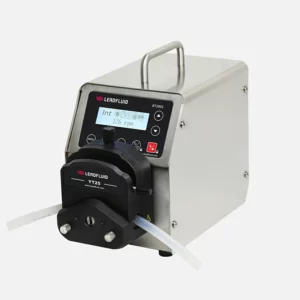When using a variable speed peristaltic pump, it’s essential to follow safety precautions to prevent accidents, ensure operator safety, and maintain the integrity of the equipment.
Here are some safety precautions to consider:
- Read the Manual: Before operating the variable speed peristaltic pump, thoroughly read and understand the manufacturer’s operating instructions, safety guidelines, and warnings provided in the user manual. Familiarize yourself with the pump’s controls, features, and recommended operating procedures.
- Proper Installation: Install the peristaltic pump on a stable, level surface that can support its weight and minimize vibration during operation. Ensure that all electrical connections, tubing connections, and fluid lines are secure and properly tightened to prevent leaks or disconnections.
- Electrical Safety: Follow electrical safety practices when connecting the peristaltic pump to power sources. Use grounded electrical outlets, extension cords, and power cables rated for the pump’s voltage and current requirements. Avoid overloading circuits and use circuit breakers or fuses as necessary for protection against electrical faults.
- Grounding: Ensure that the peristaltic pump is properly grounded according to the manufacturer’s recommendations. Grounding helps prevent electrical hazards, static buildup, and potential damage to electronic components. Use grounding straps, conductive surfaces, or grounding rods as required to establish a reliable ground connection.
- Personal Protective Equipment (PPE): Wear appropriate personal protective equipment, such as safety glasses, gloves, and lab coats, when operating the peristaltic pump to protect against chemical exposure, splashes, or spills. Use additional PPE as needed based on the specific hazards associated with the pumped fluids.
- Chemical Compatibility: Verify the compatibility of the pump materials, tubing, and seals with the fluids being pumped to prevent chemical reactions, degradation, or damage to the equipment. Consult chemical compatibility charts, material safety data sheets (MSDS), variable speed peristaltic pump and manufacturer specifications for guidance on safe handling practices.
- Ventilation: Ensure adequate ventilation in the area where the peristaltic pump is operated to prevent the accumulation of fumes, vapors, or airborne contaminants. Use fume hoods, exhaust fans, or other ventilation systems as necessary to maintain a safe working environment and minimize exposure to hazardous substances.
- Emergency Stop: Locate and familiarize yourself with the emergency stop button or switch on the peristaltic pump. Be prepared to quickly shut down the pump in case of an emergency, equipment malfunction, or unexpected hazard. Test the emergency stop function periodically to ensure proper operation.
- Monitoring and Supervision: Supervise the operation of the peristaltic pump at all times, especially when handling hazardous or volatile fluids. Monitor the pump’s performance, fluid flow, and pressure levels regularly to detect any abnormalities, leaks, or malfunctions. Respond promptly to any alarms, warnings, or unusual sounds.
- Training and Certification: Ensure that operators receive proper training and certification in the safe operation, maintenance, and troubleshooting of the variable speed peristaltic pump. Provide ongoing education and refresher training to reinforce safety protocols and best practices.
By following these safety precautions and guidelines, you can minimize risks, protect personnel, and promote safe operation when using a variable speed peristaltic pump in laboratory, industrial, or research settings. Always prioritize safety and adhere to established protocols to prevent accidents, injuries, and equipment damage.
